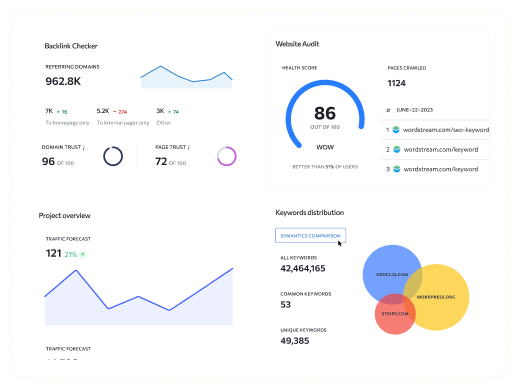Encountering a “404 page not found” error can be frustrating for users, but a well-designed Wix 404 page can turn this negative experience into a positive one. This article will guide you through creating an effective custom 404 page on Wix, enhancing both user experience and SEO.
A 404 page is what visitors see when they click on a broken link or mistyped URL. While these pages are often overlooked, they play a crucial role in retaining visitors and maintaining SEO health. In this guide, we’ll explore the benefits of a well-designed 404 Wix page, best practices for customization, and tools to manage these pages effectively.
Understanding the Wix 404 Page
Definition of a 404 Page: A 404 page is an error page displayed when a web server cannot find the requested resource. It indicates that the content is either moved or deleted. These pages are crucial for signaling to both users and search engines that the requested URL does not lead to a valid webpage.
Importance of Having a Custom 404 Page: A custom 404 page on Wix helps guide users back to useful content, reducing frustration and bounce rates. Without a custom 404 page, users might feel lost and leave your site immediately, which can negatively impact user engagement metrics and overall site performance.
Explanation of HTTP Error Code 404: HTTP status code 404 means “Not Found.” It signals that the server can’t locate the requested URL. This code is an important part of web communication, helping both browsers and search engines understand the status of a requested page.
Benefits of a Well-Designed Wix 404 Page
User Experience Benefits:
- Avoid User Frustration: A well-designed 404 Wix page provides helpful information, preventing users from feeling lost. By offering clear navigation options and a friendly message, you can mitigate the negative impact of a broken link.
- Guide Users to Relevant Pages: Offer links to popular pages or a search bar to help users find what they need. For instance, including links to your homepage, contact page, or site map can be highly beneficial.
Visual Benefits:
- Create a Positive Impression: Attractive design can enhance user perception of your site. A visually appealing 404 page reflects well on your brand, showing that you care about every detail of the user experience.
- Aesthetics-Usability Effect: Users are more forgiving of minor usability issues when the design is visually appealing. This means a beautifully designed 404 page can help retain visitors who might otherwise leave.
Marketing Benefits:
- Strengthen Brand Image: A custom Wix 404 page can reinforce your brand’s identity. By incorporating your brand’s colors, fonts, and style, you create a consistent experience across your site.
- Conversion Opportunities: Use the 404 page to direct users to high-value pages, improving engagement. For example, you can include links to your best-performing blog posts or special offers.
Best Practices for Designing a Wix 404 Page
Keep it Simple:
- Minimal Text and Visual Clutter: Ensure the page is easy to understand at a glance. Users should immediately recognize they’ve hit a 404 error and know what to do next.
- Clear and Concise Messages: Direct users with straightforward instructions. Instead of lengthy explanations, use short and friendly messages like, “Oops! The page you’re looking for isn’t here.”
Avoid Generic Messages:
- Human-Friendly Tone: Use relatable language like, “Oops! This page doesn’t exist.” Generic messages can feel cold and uninviting, so aim for a tone that aligns with your brand voice.
- Creative Examples: For instance, “404. Page was sucked into the vortex!” with visual effects. Adding a touch of humor or creativity can make the experience more enjoyable.
Maintain Visual Consistency:
- Align with Site Branding: Use the same colors, fonts, and styles as the rest of your site. This consistency helps users feel they’re still within your website’s ecosystem.
- Examples of Consistent Pages: Look at Mailchimp’s 404 page for inspiration. Their 404 page maintains the same design language as the rest of their site, providing a seamless experience.
Make the Page Functional:
- Offer Next Steps: Provide links to the homepage or other key pages. A functional 404 page helps users quickly find their way back to relevant content.
- Incorporate Navigation Options: Consider adding a search bar or top-level menu. This allows users to continue their journey on your site without having to start over.
Add Relevant Imagery:
- Visual Communication: Use images to quickly convey the message. Relevant imagery can make the page more engaging and less frustrating for users.
- Effective Imagery Examples: Spotify uses a vinyl disk illustration on its 404 page. This image is immediately recognizable to their audience and reinforces their brand.
Use Generous Whitespace:
- Enhance Readability and Focus: More whitespace helps key elements stand out. By reducing visual clutter, you make it easier for users to navigate the page.
- Whitespace Usage Examples: Check out CUSP’s 404 page for a balanced design. Their use of whitespace directs attention to the key message and navigation options.
Utilize Brand Attributes:
- Showcase Brand Identity: Reflect what your company does visually. For example, if you’re a video production company, use imagery or design elements related to video.
- Branded 404 Pages: Myriad Video uses classic TV color bars to signify video production. This visual cue immediately tells users what the company does.
Introduce Creative Visual Effects:
- Dynamic and Engaging: Use animations to keep users interested. Animated elements can draw attention and make the page more interactive.
- Engaging Visual Effects: Andrea Reni’s 404 page features a glitch animation. This creative touch adds a layer of sophistication to the error page.
Add a Dose of Humor:
- Connect with Users: A funny 404 page can leave a lasting impression. Humor can make a frustrating experience more pleasant and memorable.
- Humorous Examples: Romain Brasier’s page includes a game to save falling lemmings. This unique approach not only entertains but also keeps users engaged longer.
Include Unexpected but Useful Features:
- Offer Additional Functionalities: Surprise users with helpful tools. Adding extra features can turn a negative experience into a positive one.
- Useful 404 Page Features: Dribbble’s HEX color generator is a unique addition. This tool is relevant to their design-oriented audience and provides value even on an error page.
How to Create and Customize Your Wix 404 Page
Step-by-Step Guide:
- Create a New Page in Wix Editor:
- Go to the Wix editor and create a new page named “error404.” This will be the basis for your custom 404 page.
- Hide the Page from the Menu:
- Ensure it doesn’t appear in the main navigation. You want this page to be accessible only when a 404 error occurs.
- Customize the Content and Design:
- Add clear messages, links to key pages, and relevant imagery. Ensure the design aligns with your overall site branding.
- Add Navigation and Links:
- Include links to the homepage, popular sections, or a search bar. This helps users find their way back to useful content.
- Publish the 404 Page:
- Save and publish your changes to make the page live. Test it to ensure it appears correctly when a 404 error is encountered.
Tools to Help You Manage 404 Pages on Wix
Google Search Console:
- Find and Fix 404 Errors: Use the Crawl Errors report to identify broken links. This tool provides a comprehensive list of 404 errors that need addressing.
SEMRush:
- Site Audit and Issue Identification: Comprehensive tools to detect 404 pages. SEMRush offers insights into how these errors affect your site’s SEO.
Screaming Frog:
- SEO Issue Detection: Easy-to-use tool for finding and fixing SEO problems. Screaming Frog can crawl your site and identify any 404 errors.
SEO Considerations for Wix 404 Pages
Impact of 404 Pages on SEO:
- Avoiding Penalties: Properly handle 404 errors to maintain good SEO health. Ensure that all 404 pages are custom and provide useful navigation options.
- Importance of Proper Redirects: Use 301 redirects to guide users from broken links to relevant content. This helps preserve link equity and improves user experience.
Handling Soft 404 Errors:
- Definition and Impact on SEO: Soft 404 errors occur when a page returns a “200 OK” status but is essentially a 404 error. These can confuse search engines and harm SEO.
- Fixing Soft 404 Errors: Ensure such pages return the correct status code or redirect them properly. Use tools like Google Search Console to identify and address soft 404 errors.
Common Mistakes to Avoid with Wix 404 Pages
Relying Too Heavily on 404 Pages:
- Reduce 404 Page Occurrences: Regularly check for and fix broken links. A well-maintained site should minimize the frequency of 404 errors.
Neglecting Routine Maintenance:
- Perform Regular Checks: Use tools like Google Search Console to identify issues. Routine maintenance helps ensure that your site remains user-friendly and SEO-optimized.
Ignoring Common User Typos:
- Redirect Common Misspellings: Create redirects for frequently mistyped URLs. This can prevent users from encountering 404 errors due to simple typos.
Overlooking Caching Issues:
- Clear Caches to Resolve Errors: Suggest users clear their browser cache if persistent 404 errors occur. Caching issues can sometimes cause 404 errors even when the page exists.
Turning Failures into Opportunities
Viewing 404 Pages as a Chance to Engage Users:
- Direct Users Towards Meaningful Actions: Provide useful links and information to keep users on your site. Turn a potential dead-end into an opportunity to engage and retain visitors.
Examples of Successful 404 Page Strategies:
- Engaging Designs: Use creative and interactive elements to make the 404 page memorable. For example, adding a mini-game or interactive feature can delight users and encourage them to stay on your site longer.
Conclusion:
Creating a custom Wix 404 page is not just about fixing errors—it’s an opportunity to improve user experience and SEO. By following the best practices outlined above, you can transform a potential dead-end into a valuable asset for your website. Ensure your Wix edit 404 page is visually appealing, functional, and aligned with your brand to keep visitors engaged and enhance your site’s overall performance.
Note: Read Our Latest Marketing and SEO Blogs: AI SEO for Wix | BigCommerce Status and Ensuring Seamless | SEO Practices for Wix | What is Wix | Wix SEO Friendly | Wix vs WordPress SEO | Wix SEO Apps | Wix vs Squarespace SEO .
Frequently Asked Questions
Q1. Why is a custom 404 page important?
A1: A custom 404 page improves user experience, reduces bounce rates, and can positively impact SEO.
Q2. How do I create a custom 404 page in Wix?
A2: Use the Wix editor to create a new page named “error404,” hide it from the menu, customize it, and publish.
Q3. What should I include on my Wix 404 page?
A3: Include clear messages, links to key pages, relevant imagery, and a search bar.
Q4. Can a 404 page affect my website’s SEO?
A4: Yes, improperly handled 404 errors can hurt SEO. Use proper redirects and fix soft 404 errors to maintain SEO health.
Q5. What tools can help manage 404 pages on Wix?
A5: Tools like Google Search Console, SEMRush, and Screaming Frog can help identify and fix 404 errors.





